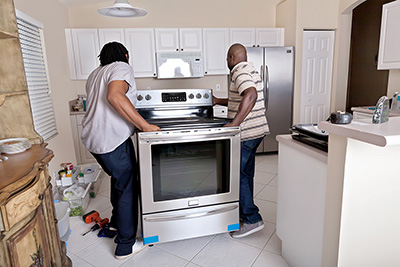Avoiding Common Headaches When Buying Appliances
Last updated May 2023
 Get all terms in writing.
Get all terms in writing.
Get an invoice or contract that lists the store’s name, address, and phone number; your name and address; appliance brand and model number; price for each appliance; itemized prices for delivery, hauling away old appliances, and installation; deposit paid; terms for refunds and exchanges; and expected delivery date.
Avoid leaving a large deposit.
It’s reasonable for a store to require a small upfront deposit. But making a large deposit deprives you of the leverage you may need to make sure all goes as planned.
Pay by credit card.
If you have a problem, you can protest the charge with your credit card issuer.
Measure. Twice.
Don’t wait until your new appliance arrives to find that it won’t fit through your doors, up a stairwell, into the allotted space, or that you can’t fully open a dishwasher or fridge door without banging into the counter across from it.
Check right away for visible defects.
Reject delivery of an appliance that arrives scratched, dented, or otherwise damaged. If the problem is limited to cosmetic damage, and you need a working appliance while you await a defect-free replacement, call the store manager and ask if you can keep the lemon/ugly duckling while you wait.
After installation, check that the appliance works.
Before the installers leave, make sure burners burn, the oven bakes and broils, the fridge cools, the icemaker makes cubes, etc. Check carefully for water leaks. If you notice a problem after the store’s installers leave, inform the store as soon as possible—and push it to provide a replacement unit, rather than forcing you to seek repairs under the manufacturer’s warranty.
Check that clothes washers are level.
Leveling a washer is one detail some delivery personnel don’t do well. An improperly leveled clothes washer can have a shorter operating life and, worse, cause a flood if the unit pulls too far away from the water supply or drainage hoses. The best way to check is to throw in a blanket or a few towels to create a slightly unbalanced load. Start the washer, letting it fill about halfway with water to get the load wet; then switch it to its spin cycle. If it does a two-step across the floor, it needs releveling.
Check gas appliances for leaks.
Ask store installers to show you how they test for leaks, and then watch them do it. Even if you don’t know how to check to make sure the work is done right, the installers won’t know you don’t know.
Confirm that anti-tipping devices for ovens are installed.
This precaution is especially important if you have small children.
Replace flimsy hoses with more reliable options.
The rubber water-supply hoses that typically come with clothes washers and dishwashers can fail. Swap them with stainless steel hoses—either when the appliance is installed or the next time you need repairs or plumbing work. It’s an easy job you can do yourself. Also, if your refrigerator’s icemaker uses a rubber or plastic water-supply line, replace it with a copper version.
Read the instruction manual.
Use proper cleaning equipment and supplies.
You don’t want to ruin your new stainless steel finish, detonate an inferno by improperly using oven cleaner, or scratch the surface of your supposedly unscratchable range.


